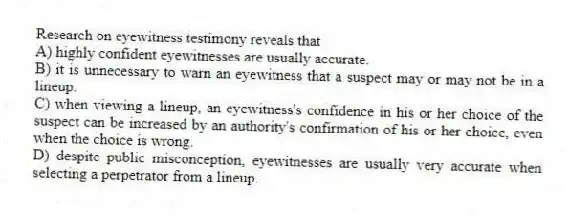
Research on eyewitness testimony reveals that
A) highly confident eyewitnesses are usually accurate.
B) it is unnecessary to warn an eyewitness that a suspect may or may not be in a lineup.
C) when viewing a lineup, an eyewitness's confidence in his or her choice of the suspect can be increased by an authority's confirmation of his or her choice, even when the choice is wrong.
D) despite public misconception, eyewitnesses are usually very accurate when selecting a perpetrator from a lineup.
Correct Answer:
Verified
Q19: A lesson to be learned from the
Q20: The idea that we remember life events
Q21: In the experiment in which participants sat
Q22: In Lindsay's "misinformation effect" experiment, participants saw
Q23: Your text's discussion of false memories leads
Q25: The experiment in which participants first read
Q26: Arkes and Freedman's "baseball game" experiment asked
Q27: "S," who had a photographic memory that
Q28: Lindsay's misinformation effect experiment, in which participants
Q29: The experiment for which people were asked
Unlock this Answer For Free Now!
View this answer and more for free by performing one of the following actions

Scan the QR code to install the App and get 2 free unlocks

Unlock quizzes for free by uploading documents